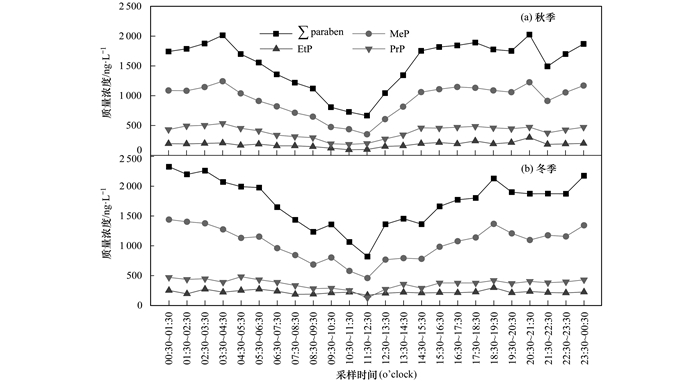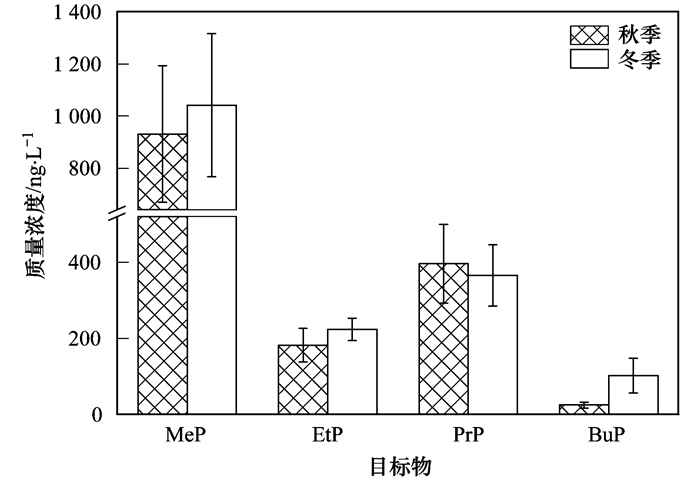与其他类型的防腐剂相比, 对羟基苯甲酸酯(parabens)具有用量少、成本低、无气味、安全性能好等特点, 被广泛应用于食品、化妆品和药品中[1, 2].自美国食品药品管理局(USFDA)批准parabens可以作为食品和化妆品的防腐剂使用, 至今已有50多年的历史.然而, 近年来的研究发现, parabens的大量使用可能对生态环境和人体健康造成危害, 具有类内分泌干扰物的性质, 动物体外实验和体内实验均表明该类防腐剂具有雌激素活性[3, 4], 长期暴喂食parabens的老鼠能够表现出荷尔蒙分泌降低的趋势, 并且影响生殖器官的正常发育[5], 所以其使用安全性也逐渐引起了人们的关注.
人类活动会向污水中释放大量的污染物, 污水处理过程对于污染物的去除起到重要作用, 然而对于难去除和难降解的污染物, 污水处理厂的出水成为环境中污染物的重要点源, 最终可能引起受纳水体中该类污染物的富集, 造成一定的生态风险[6~8].有研究表明地表水体中parabens的残留主要来自于污水的排放, 关于城市污水处理系统中parabens的归趋研究, 也逐渐引起科学界的关注.加拿大的研究发现, 多种parabens均能够在城市污水中检测到, 其中以对羟基苯甲酸甲酯(MeP)和对羟基苯甲酸丙酯(PrP)质量浓度最高[9], 西班牙污水处理厂中也检测到了相同数量级的污染水平[10~12], 在我国的香港、广州和厦门的污水处理工艺中也检测到了该类物质的高浓度残留[13~15].但是与其他类型的污染物相比, parabens在污水处理过程中的残留特征、去除过程和去除规律等的研究还比较薄弱, 缺少基础数据.
为了系统分析parabens在城市污水中的污染特征, 本研究于2016年10月和2017年01月, 分两次对哈尔滨某污水处理厂的进水进行了24h连续采集, 探讨了污水中6种parabens的浓度水平和污染特征, 进一步研究了日变化趋势和季节差异性, 以期为城市污水处理系统中parabens的深入研究和减量技术的开发提供了重要理论依据.
1 材料与方法 1.1 污水样品的采集与保存2016年10月和2017年1月, 采集了哈尔滨某典型城市污水处理厂的进水, 该污水处理厂位于松花江哈尔滨段下游的太平区东大坝外, 松花江与阿什河交汇处的河漫滩地上, 主要收集哈尔滨市马家沟沿线的居民生活污水和工业废水, 其中80%为生活污水, 20%为工业废水, 服务人口数为115万, 污水处理后直接排入松花江.污水厂主要采用A/O工艺, 主要有格栅、沉砂池、初沉池、厌氧池、好氧池和二沉池这6个处理单元.该污水处理厂设计处理水量为32.5万t·d-1, 实际为20万t·d-1, 污泥排量为250~300 t·d-1.污水采样方法为:利用自动采样器(Teledyne Isco 3700)对污水厂进水进行连续24 h的采集, 每小时采集一个样品(375 mL), 共获得48个污水样品.采样现场利用便携式多参数水质测量仪(YSI ProDSS)对污水样品的总有机碳(TOC)、总溶解固体(TDS)、酸碱度(pH)和铵根离子(NH4+)等进行现场测定.污水样品在4℃的冰箱中保存.
本研究共选择了6种parabens作为目标物, 分别为:对羟基苯甲酸甲酯(MeP)、对羟基苯甲酸乙酯(EtP)、对羟基苯甲酸丙酯(PrP)、对羟基苯甲酸丁酯(BuP)、对羟基苯甲酸苄酯(BzP)、对羟基苯甲酸庚酯(HepP), 分子结构如图 1所示.

|
图 1 Parabens的分子结构 Fig. 1 Molecular structure of parabens |
污水样品的处理采用固相萃取法, 详细步骤为:取20 mL污水样品于1 L玻璃瓶中, 加纯水稀释到800 mL, 加入50 ng13C标记的混合代标(13C-MeP、13C-EtP、13C-PrP和13C-BuP), 混合均匀.将混合后的水样, 通过隔膜泵抽取上样于已经用6 mL二氯甲烷、6 mL甲醇和6 mL纯水活化处理过的HLB固相萃取柱(6 cm3, 500 mg, Waters公司), 流速控制为1滴·s-1, 上样结束后真空抽干1 h, 再用7 mL甲醇和7 mL二氯甲烷洗脱, 洗脱液收集于玻璃试管中, 氮吹浓缩至1 mL.再取7 mL甲醇和7 mL二氯甲烷润洗样品瓶, 润洗液通过同样的方法进行处理, 与第一次的洗脱液混合后, 氮吹浓缩至1 mL, 转移至棕色样品瓶中, 密封、低温保存, 待仪器分析.
1.3 parabens的仪器分析方法采用液相色谱质谱联用仪进行检测, 仪器型号为安捷伦LC1290-MS/MS6430.色谱柱型号为ZORBAX RRHD Eclipse Plus C18(100×2.1 mm, 1.8 μm), 柱温为30℃, 流动相为甲醇和含0.05%甲酸和5 mmol·L-1醋酸铵的超纯水溶液(取5 mmol·L-1, 0.3854 g醋酸铵, 500 μL甲酸溶解在1 L超纯水中), 流速为0.5 mL·min-1, 梯度洗脱程序如表 1所示.进样量为5 μL.质谱选择Dynamic MRM模式, 特征离子和出峰时间分别为:MeP(151 > 92, 1.21 min)、EtP(165 > 92, 1.41 min)、PrP(179 > 92, 1.58 min)、BuP(193 > 92, 1.83 min)、BzP(227 > 92, 1.80 min)、HepP(235 > 92, 2.63 min)、13C6-MeP(157 > 98, 1.20 min)、13C6-EtP(171 > 98, 1.40 min)、13C6-PrP(185>98, 1.61 min)和13C6-BuP(199 > 98, 2.0 min), 电喷雾电离(ESI), 毛细管电压为-3 500 V, 喷雾器压力为-40 V, 去溶剂气温度为300℃.
|
|
表 1 HPLC梯度洗脱程序1) Table 1 Gradient elution program of HPLC |
1.4 质量控制和质量保证
在样品处理过程中, 同时进行2个空白实验和2个基质加标实验, 处理方法与污水样品的处理方法相同, 用以检验方法的回收率和基质干扰效应.空白样品中parabens的检出浓度远低于其在真实样品中的浓度, 本文所报道的浓度数据均已扣除空白值.基质加标样品中6种parabens的平均回收率为102%±7%, 说明基质效应较小.另外, 为了考察样品处理过程中的回收率, 所有样品在处理前均加入4种parabens的代标(13C-MeP、13C-EtP、13C-PrP和13C-BuP), 结果表明其回收率平均值为112%±3%, 说明该回收率较好, 本文所报道的浓度数据均经过了代标回收率校正.按照信噪比为10时的标样浓度作为方法定量限, 检测方法中目标物的定量限分布在0.01~0.02 ng·mL-1之间. Spearman相关性分析采用SPSS V22.0进行, 当P < 0.05时, 认为两组数据之间具有显著性的统计学意义, 当P < 0.01时, 认为两组数据之间具有非常显著性的统计学意义.
2 结果与讨论 2.1 污水中parabens的质量浓度及质量负荷表 2为parabens在哈尔滨某典型城市污水处理厂进水中的浓度.从中可以看出, MeP、EtP、PrP和BuP在所有样品中均有检出(检出率为100%), 而BzP和HepP的检出率较低, 分别为58.3%和18.8%.由于BzP和HepP的检出率较低, 所以在后续的分析中没有涉及该目标物.整体浓度来看, MeP的质量浓度最高, 平均质量浓度为942 ng·L-1, 其次是PrP(367 ng·L-1)和EtP(198ng·L-1).组成来看, 这3种parabens是该城市污水中的主要目标物, 这种组成特征与我国的食品、药品和洗护用品中parabens的研究结果相同[16~18], 说明在我国生产和使用的parabens中, MeP、EtP和PrP是主要成分, 随着人们的使用, 最终进入到城市污水中.
|
|
表 2 哈尔滨某典型城市污水中6种parabens的质量浓度1)/ng·L-1 Table 2 Concentration of six parabens in a typical wastewater treatment plant in Harbin/ng·L-1 |
污水处理厂中检出率较高的4种parabens及总parabens的质量负荷由parabens在进水中的质量浓度、每日处理量和污水处理厂的服务人口数计算得到, 结果如图 2所示. MeP、PrP、EtP和BuP的质量负荷分别为172、66.3、35.3和11.1 mg·(d·1 000人)-1, 总parabens的质量负荷达到284 mg·(d·1 000人)-1.本文的研究结果与美国[46.3~176 mg·(d·1 000人)-1][19]和印度[4.1~140 mg·(d·1 000人)-1][20]的研究结果相似, 却远低于丹麦[2 750 mg·(d·1 000人)-1][21]和法国[30 400 mg·(d·1 000人)-1][22]的研究数据.这与污水处理厂的服务人口数及污水来源有关.

|
图 2 Parabens在污水处理厂中的质量负荷 Fig. 2 Mass loadings of parabens in the wastewater treatment plant |
通过与国内外其他相似的研究结果对比(见表 3), 可以看出, MeP、EtP和PrP在所有国家的城市污水中也都是主要的目标物, 说明它们的生产和使用在不同国家具有相似性.从单一目标物的对比可以看出, 不同国家的检出质量浓度具有较大的差异.哈尔滨城市污水中MeP的质量浓度要高于中国广州、香港、厦门、美国奥尔巴尼和西班牙巴伦西亚等地的污水中的检出质量浓度[19, 23, 24], 却远低于美国加利福尼亚、西班牙、英国威尔士、丹麦哥本哈根、德国莱比锡城和法国巴黎等地的污水中的检出质量浓度[10~12, 22, 25~31].与MeP相似, 其他几种parabens也有类似的结果.综上所述, 中国城市污水中parabens的检出质量浓度较低, 但是在中国食品、化妆品和药品中检测到的parabens的质量浓度整体上要高于美国. Liao等对中国13大类282个食品样品进行了检测, 发现99%的食品中含有parabens, MeP、EtP和PrP也是主要的目标污染物, 食品中Σparabens质量浓度的中位数为3.09 ng·g-1, 大于美国食品中parabens的质量浓度(0.92 ng·g-1)[16, 32]; 通过对美国和中国药品中parabens的质量浓度结果进行对比发现, 中国药品中Σparabens的质量浓度比美国高一个数量级[17, 33]; 而中国化妆品中parabens的浓度水平与美国相当[18].
|
|
表 3 全球城市污水处理厂进水中parabens质量浓度比较1)/ng·L-1 Table 3 Comparison of the concentration of parabens in the influent of global waste water treatment plants/ng·L-1 |
2.2 污水中parabens的日变化规律
通过对秋冬两季城市污水处理厂24 h的进水进行分析, 对parabens质量浓度的日变化趋势进行了深入研究, 结果如图 3所示.从中可以看出, 秋冬两季主要目标物和总parabens质量浓度的日变化规律均相同, 24 h的质量浓度存在较大的变化, 秋冬两季质量浓度最低值都出现在11:30~12:30之间, 此时秋冬季parabens的总质量浓度分别为664ng·L-1和819ng·L-1; 秋冬季质量浓度最高点分别出现在晚间20:30~21:30之间和凌晨00:30~01:30之间, 此时parabens的质量浓度分别为2 030ng·L-1和2 330ng·L-1, 分别是最低质量浓度的3.05倍和2.84倍, 由此可知秋冬季节进水中parabens的最高排放时期有一定的差异, 但是秋冬季节的日变化趋势差异不大.污水中parabens的质量浓度日变化趋势与污水厂覆盖区域人们的日常生活有关, 如洗漱活动, 但是污水从居民家的排放到污水处理厂需要一定的时间.从图 3中可以看出, 无论是秋季还是冬季, parabens质量浓度较低的时间大概有8~9 h, 正好与人们日常生活中的睡觉时间保持一致, 也证明了城市污水中parabens的污染主要是人们的日常生活导致的.本文对24 h进水中parabens的质量浓度日变化趋势的研究结果为城市污水处理系统研究提供了重要参考, 特别是对水样的采集时间的合理设置提供了参考.因此, 在进行城市污水处理厂运行效果的相关研究中, 针对进水的采集, 最好采集不同时间段的水样进行混合, 否则可能由于单次采样带来较大误差, 例如可以在24 h内, 每隔几个小时进行一次水样采样, 然后混合为一个样品, 或者根据24 h内污染物浓度的日变化趋势, 选择浓度的高峰或者低峰为节点, 按照污水处理厂各个污水处理单元的水力停留时间进行采样.

|
图 3 Parabens在24 h连续进水中浓度变化趋势 Fig. 3 Variation in the concentration of parabens in the 24-hour influent samples |
为了研究常规水质指标与parabens质量浓度的关系, 本研究对污水样品中的5种常规水质指标进行检测, 它们与4种检出率为100%的parabens的质量浓度的相关性结果见表 4所示. BuP与EtP没有相关性, MeP、EtP与PrP两两之间均具有极显著相关性(P < 0.01), 相关系数在0.585到0.892之间, 说明它们具有相同的来源.在我国的食品、药品和洗护用品的研究中, 也发现了它们之间的显著相关性[16~18]. TOC与EtP和BuP具有显著相关(P < 0.05), 相关系数分别为0.465和0.428;与MeP和PrP具有极显著相关(P < 0.01), 相关系数分别为0.744和0.707;整体而言, TOC与MeP、EtP、PrP和BuP均具有显著的正相关性, 说明随着污水中MeP、EtP、PrP和BuP的质量浓度增高, TOC的含量也变大. TDS与PrP具有极显著相关(P < 0.01), 相关系数为0.621, 与MeP具有显著相关(P < 0.05), 相关系数为0.498. pH与MeP和PrP具有极显著相关(P < 0.01), 相关系数分别为-0.582、-0.612和0.804, 即pH与MeP和PrP成负相关.
|
|
表 4 污水中parabens的质量浓度与常规水质指标的相关性系数1) Table 4 Correlation between concentrations of parabens and conventional water index |
2.4 污水中parabens质量浓度的季节变化
图 4为污水中parabens的质量浓度随季节变化的趋势, 由于BzP和HepP的质量浓度和检出率均较低, 所以没有在图中显示.从中可以看出, 秋季和冬季的城市污水样品中, 6种parabens的组成特征没有发生明显的变化, MeP、EtP和PrP都是主要的目标物, 三者之和的比例分别占总浓度的98.1%和94.0%, 但是, 不同parabens的质量浓度的季节变化趋势具有差异, MeP、EtP和BuP在冬季的平均质量浓度要高于秋季, 变化率分别为11.9%、22.8%和311%, 说明MeP和EtP的质量浓度并没有发生明显的变化, 而BuP的质量浓度发生了明显的季节变化. PrP的平均质量浓度秋季略高于冬季, 但变化并不明显, 变化率仅为8.34%.整体来看, 这3种主要parabens的季节变化差异性不大, 也反映了城市污水中parabens的质量浓度稳定性.整体而言, 城市污水是parabens的一个重要汇, 如果常规的污水处理工艺不能够对该类化合物进行有效的去除, 其出水可能成为受纳水体的重要污染源, 所以在未来的研究中有必要针对城市污水处理系统中parabens的去除效果和去除途径进行系统的研究.

|
图 4 城市污水厂进水中parabens浓度的季节变化 Fig. 4 Seasonal variation of the concentrations of parabens in the influent |
(1) 通过对哈尔滨某典型城市污水中6种parabens的检测发现, parabens的污染较为普遍, MeP、EtP和PrP是主要的目标物, 与发达国家相比, 其污染程度较轻.
(2) 常规水质参数TOC、TDS和pH与parabens的浓度具有一定的相关性, 但其影响具有差异性.
(3) 城市污水中parabens的质量浓度具有明显的日变化趋势, 因此在污水采样的过程中要考虑对24 h的样品进行混合或者按照污水处理单元的水力停留时间进行采样.
(4) 城市污水中parabens的质量浓度不具有明显的季节差异, 如果常规工艺不能完全去除, 污水厂出水可能成为受纳水体的重要污染源.
| [1] |
林忠洋, 马万里, 齐迹, 等. 对羟基苯甲酸酯类防腐剂的人体暴露[J]. 化学进展, 2015, 27(5): 614-622. Lin Z Y, Ma W L, Qi J, et al. Human exposure to parabens[J]. Procress in Chemistry, 2015, 27(5): 614-622. |
| [2] | Soni M G, Carabin I G, Burdock G A. Safety assessment of esters of p-hydroxybenzoic acid (parabens)[J]. Food and Chemical Toxicology, 2005, 43(7): 985-1015. DOI:10.1016/j.fct.2005.01.020 |
| [3] | Darbre P D, Byford J R, Shaw L E, et al. Oestrogenic activity of isobutylparaben invitroand invivo[J]. Journal of Applied Toxicology, 2002, 22(4): 219-226. DOI:10.1002/(ISSN)1099-1263 |
| [4] | Lemini C, Jaimez R, ávila M E, et al. In vivo and in vitro estrogen bioactivities of alkyl parabens[J]. Toxicology and Industrial Health, 2003, 19(2-6): 69-79. DOI:10.1191/0748233703th177oa |
| [5] | Oishi S. Effects of butylparaben on the male reproductive system in rats[J]. Toxicology and Industrial Health, 2001, 17(1): 31-39. DOI:10.1191/0748233701th093oa |
| [6] |
甘秀梅, 严清, 高旭, 等. 典型抗生素在中国西南地区某污水处理厂中的行为和归趋[J]. 环境科学, 2014, 35(5): 1817-1823. Gan X M, Yan Q, Gao X, et al. Occurrence and fate of typical antibiotics in a wastewater treatment plant in southwest China[J]. Environmental Science, 2014, 35(5): 1817-1823. |
| [7] |
乔梦, 齐维晓, 赵旭, 等. 多环芳烃及其衍生物在北京典型污水处理厂中的存在及去除[J]. 环境科学, 2016, 37(4): 1451-1459. Qiao M, Qi W X, Zhao X, et al. Occurrence and removal of polycyclic aromatic hydrocarbons and their derivatives in typical wastewater treatment plants in Beijing[J]. Environmental Science, 2016, 37(4): 1451-1459. |
| [8] |
张秋亚, 马晓妍, 王晓昌, 等. 典型生活污水处理工艺对雌激素效应的去除[J]. 环境科学, 2017, 38(4): 1506-1512. Zhang Q Y, Ma X Y, Wang X C, et al. Removal of estrogenic effect by typical domestic wastewater treatment processes[J]. Environmental Science, 2017, 38(4): 1506-1512. |
| [9] | Lee H B, Peart TE, Svoboda ML. Determination of endocrine-disrupting phenols, acidic pharmaceuticals, and personal-care products in sewage by solid-phase extraction and gas chromatography-mass spectrometry[J]. Journal of Chromatography A, 2005, 1094(1-2): 122-129. DOI:10.1016/j.chroma.2005.07.070 |
| [10] | Blanco E, Casais MD C, Mejuto MC, et al. Combination of off-line solid-phase extraction and on-column sample stacking for sensitive determination of parabens and p-hydroxybenzoic acid in waters by non-aqueous capillary electrophoresis[J]. Analytica Chimica Acta, 2009, 647(1): 104-111. DOI:10.1016/j.aca.2009.05.024 |
| [11] | Bratkowska D, Marcé R M, Cormack P A G, et al. Development and application of a polar coating for stir bar sorptive extraction of emerging pollutants from environmental water samples[J]. Analytica Chimica Acta, 2011, 706(1): 135-142. DOI:10.1016/j.aca.2011.08.028 |
| [12] | González-Mariño I, Quintana JB, Rodríguez I, et al. Evaluation of the occurrence and biodegradation of parabens and halogenated by-products in wastewater by accurate-mass liquid chromatography-quadrupole-time-of-flight-mass spectrometry (LC-QTOF-MS)[J]. Water Research, 2011, 45(20): 6770-6780. DOI:10.1016/j.watres.2011.10.027 |
| [13] | Yu Y Y, Huang Q X, Wang Z F, et al. Occurrence and behavior of pharmaceuticals, steroid hormones, and endocrine-disrupting personal care products in wastewater and the recipient river water of the Pearl River Delta, South China[J]. Journal of Environmental Monitoring, 2011, 13(4): 871-878. DOI:10.1039/c0em00602e |
| [14] | Yu K, Li B, Zhang T. Direct rapid analysis of multiple PPCPs in municipal wastewater using ultrahigh performance liquid chromatography-tandem mass spectrometry without SPE pre-concentration[J]. Analytica Chimica Acta, 2012, 738: 59-68. DOI:10.1016/j.aca.2012.05.057 |
| [15] | Sun Q, Li M Y, Ma C, et al. Seasonal and spatial variations of PPCP occurrence, removal and mass loading in three wastewater treatment plants located in different urbanization areas in Xiamen, China[J]. Environmental Pollution, 2016, 208: 371-381. DOI:10.1016/j.envpol.2015.10.003 |
| [16] | Liao C Y, Chen L X, Kannan K. Occurrence of parabens in foodstuffs from China and its implications for human dietary exposure[J]. Environment international, 2013, 57-58: 68-74. DOI:10.1016/j.envint.2013.04.001 |
| [17] | Ma W L, Zhao X, Lin Z Y, et al. A survey of parabens in commercial pharmaceuticals from China and its implications for human exposure[J]. Environment International, 2016, 95: 30-35. DOI:10.1016/j.envint.2016.07.013 |
| [18] | Guo Y, Wang L, Kannan K. Phthalates and parabens in personal care products from China:concentrations and human exposure[J]. Archives of Environmental Contamination and Toxicology, 2014, 66(1): 113-119. DOI:10.1007/s00244-013-9937-x |
| [19] | Wang W, Kannan K. Fate of parabens and their metabolites in two wastewater treatment plants in New York State, United States[J]. Environmental Science &Technology, 2016, 50(3): 1174-1181. |
| [20] | Karthikraj R, Vasu A K, Balakrishna K, et al. Occurrence and fate of parabens and their metabolites in five sewage treatment plants in India[J]. Science of the Total Environment, 2017, 593-594: 592-598. DOI:10.1016/j.scitotenv.2017.03.173 |
| [21] | Eriksson E, Andersen H R, Madsen T S, et al. Greywater pollution variability and loadings[J]. Ecological Engineering, 2009, 35(5): 661-669. DOI:10.1016/j.ecoleng.2008.10.015 |
| [22] | Gasperi J, Geara D, Lorgeoux C, et al. First assessment of triclosan, triclocarban and paraben mass loads at a very large regional scale:case of Paris conurbation (France)[J]. Science of the Total Environment, 2014, 493: 854-861. DOI:10.1016/j.scitotenv.2014.06.079 |
| [23] | Chen Z F, Ying G G, Lai H J, et al. Determination of biocides in different environmental matrices by use of ultra-high-performance liquid chromatography-tandem mass spectrometry[J]. Analytical and Bioanalytical Chemistry, 2012, 404(10): 3175-3188. DOI:10.1007/s00216-012-6444-2 |
| [24] | Carmona E, Andreu V, Picó Y. Occurrence of acidic pharmaceuticals and personal care products in Turia River Basin:from waste to drinking water[J]. Science of the Total Environment, 2014, 484: 53-63. DOI:10.1016/j.scitotenv.2014.02.085 |
| [25] | Loraine GA, Pettigrove ME. Seasonal variations in concentrations of pharmaceuticals and personal care products in drinking water and reclaimed wastewater in southern california[J]. Environmental Science & Technology, 2006, 40(3): 687-695. |
| [26] | Canosa P, Rodríguez I, Rubí E, et al. Optimisation of a solid-phase microextraction method for the determination of parabens in water samples at the low ng per litre level[J]. Journal of Chromatography A, 2006, 1124(1-2): 3-10. DOI:10.1016/j.chroma.2006.03.045 |
| [27] | Pedrouzo M, Borrull F, Marcé R M, et al. Ultra-high-performance liquid chromatography-tandem mass spectrometry for determining the presence of eleven personal care products in surface and wastewaters[J]. Journal of Chromatography A, 2009, 1216(42): 6994-7000. DOI:10.1016/j.chroma.2009.08.039 |
| [28] | Kasprzyk-Hordern B, Dinsdale R M, Guwy A J. Multiresidue methods for the analysis of pharmaceuticals, personal care products and illicit drugs in surface water and wastewater by solid-phase extraction and ultra performance liquid chromatography-electrospray tandem mass spectrometry[J]. Analytical and Bioanalytical Chemistry, 2008, 391(4): 1293-1308. DOI:10.1007/s00216-008-1854-x |
| [29] | Kasprzyk-Hordern B, Dinsdale R M, Guwy A J. The removal of pharmaceuticals, personal care products, endocrine disruptors and illicit drugs during wastewater treatment and its impact on the quality of receiving waters[J]. Water Research, 2009, 43(2): 363-380. DOI:10.1016/j.watres.2008.10.047 |
| [30] | Andersen H R, Lundsbye M, Wedel H V, et al. Estrogenic personal care products in a greywater reuse system[J]. Water Science and Technology, 2007, 56(12): 45-49. DOI:10.2166/wst.2007.821 |
| [31] | Kusk K O, Krüger T, Long M H, et al. Endocrine potency of wastewater:contents of endocrine disrupting chemicals and effects measured by in vivo and in vitro assays[J]. Environmental Toxicology and Chemistry, 2011, 30(2): 413-426. DOI:10.1002/etc.v30.2 |
| [32] | Liao C Y, Liu F, Kannan K. Occurrence of and dietary exposure to parabens in foodstuffs from the United States[J]. Environmental Science &Technology, 2013, 47(8): 3918-3925. |
| [33] | Moreta C, Tena M T, Kannan K. Analytical method for the determination and a survey of parabens and their derivatives in pharmaceuticals[J]. Environmental Research, 2015, 142: 452-460. DOI:10.1016/j.envres.2015.07.014 |
 2018, Vol. 39
2018, Vol. 39


